We live in absurd times. Here is a bit of hard evidence: Seven Northern White rhinos remain on this earth; not one lives in the wild.
Four live here at the Ol Pejeta Conservancy in Kenya. Two others live at a Safari Park at the San Diego zoo and one remains at the Dvur Kralove zoo in the Czech Republic.
Today, my Project Kenya Sister School colleague, Alison Stuart, and I are spending time with the most critically endangered mammal species in the world. The four Northern Whites arrived here at the Ol Pejeta Conservancy on December 20, 2009 in order to take part in a last ditch breeding program. The project is a joint effort among Fauna and Flora International, Back to Africa, Lewa Wildlife Conservancy, Kenya Wildlife Service, Dvur Kravlove Zoo, and the Ol Pejeta Conservancy. It is hoped that the two males, 41 year old Sudan and 32 year old Suni, and two females, 23 year old Najin, and her daughter, 12 year old Fatu, will produce offspring in order to save the species from extinction. If they are successful, the animals will eventually be returned to the wild. If not, a species that has roamed Africa for 7 million years will be reduced to pictures on web pages.
Instead of enjoying this privilege, I feel disheartened that it’s come to this. So far the breeding hasn’t been successful. Sadly, this isn’t the only challenge these animals and their dedicated keepers face. Dozens of specially trained guards protect the rhinos around the clock from aggressive poachers who risk their lives to cash in on a lucrative trade in rhino horns. Worth more than gold, the horns currently fetch $60-$100,000/kilogram. The most lucrative markets are Vietnam and China where powdered horns are believed to cure fevers, stomach ailments, strokes and nosebleeds. In 2007, a rumor circulated Vietnam that a politician beat cancer by eating powdered rhino horns. Four years later, in 2011, poachers killed the last Javan rhino in Vietnam. The politician has never been identified and many believe the story was contrived by poachers to create a market.
This is lunacy. Rhino horns are made of keratin. Not a single study exists that suggests any medicinal value. Our fingernails, toenails and hair are made of the same material.
With the Javan rhinos gone, poachers moved to Africa where the slaughter of rhinos is currently at an unprecedented high. In South Africa, where the majority of African rhinos live, almost 700 have been killed this year and the number is expected to rise to 1000 before the year is over. According to the African Wildlife Foundation, at this rate African rhinos could be extinct in the wild by 2025.
At the Ol Pejeta Conservancy, Sudan, Suni, Najin, and Fatu are royalty. A team of
ten highly trained caretakers attend the animals twenty-four hours a day. Each rhino eats 60-80 kilograms of grass per day, supplemented by hay, carrots, and bananas. At night a team of specially trained security officers operate on a rotational basis to secure the entire enclosure.
We joined German filmmaker, Frank Feustle, and his team for the day as they were collecting footage for a documentary about a fourteen year old boy named Newton Mwangi and his special relationship with the Northern Whites. We hoped to get one good shot for our annual Christmas card fundraiser for PA-MOJA.
Newton is known in his community as somewhat of a “rhino-whisperer” and is vocal about the importance of protecting this critically endangered species. He was chosen to work with the filmmakers because of his high grades and his keen interest in wildlife. On this particular day, Frank is filming Newton standing beside Sudan, the oldest male. In order to keep the nervous three-ton animal from knocking Newton flat, one of the guards, Patrick Mureithi, rubs Sudan’s belly while constantly replenishing the pile of alfalfa hay that is keeping him relatively content. Newton is shy but enthusiastic as we ask him to assume a variety of poses alongside his favorite animal.
This boy and this rhino, who have every reason to fear each other, look as symbiotic as a boy and his dog. Newton looks small and neat in his new checkered shirt and brown corduroys purchased by the film crew for this shoot. Sudan, beside him, looks utterly solid and indestructible.
Both rhino and boy have won a few of life’s lotteries but challenges remain. Although Sudan is pampered and protected and his horns have been painlessly removed in order to protect him from poachers, he is still vulnerable as the remaining stumps have enough value to make him a target. His skin, as thick as tires, appears bullet-proof. It isn’t. An AK-47, popular with poachers, would easily finish him off.
Newton’s father operates a matatu (passenger van) and his mother works the family farm which borders the wildlife conservancy. Newton’s middle class family will be able to see him through high school; however, the majority of young people in his community can not afford the books, uniforms and school fees to make it past grade eight.
Most farmers in the community see little value in the wild animals that border their farms. Baboons and elephants often cross over the conservancy fence and destroy their gardens. The electric fences protecting the wildlife keep the farmers’ livestock from rich grazing land. Although Newton and many of his neighbors understand the importance of wildlife in attracting tourist dollars, they and their families need to eat today.
Poachers work in teams. The triggerman receives up to $15,000.00. Would Newton or one of his neighbours agree to take the job knowing it would pull their families out of poverty and into Kenyan middle class? It’s difficult to judge anyone who chooses the future of his family over an animal, even one as magnificent as a rhino.
In response, local farmers and the Ol Pejeta Conservancy have recognized the need to cohabit with wildlife by blending and sharing limited resources. PA-MOJA was created in 2005 to support that effort by providing bursaries and building classrooms, libraries, and biogas stations in the community surrounding the conservancy. When farmers’ children can afford to go to school and learn in classrooms that have solid walls and floors, they are more willing to support Sudan as well as the black rhinos, elephants, hippos, lions, leopards and cheetahs that safely roam the Ol Pejeta Conservancy. Students like Newton have the opportunity to go to school and learn about the importance of wildlife in their own country. They share this information with their parents and elders who have influence in the community.
Clearly, education is the best hope these four Northern White rhinos have, both in Kenya, and in the countries that purchase their horns. If the breeding program is successful, Newton can proudly tell his children about how a community and four rhinos named Sudan, Suni, Najin, and Fatu came together to help a species survive extinction.
Silvia Knittel
UPATE: Suni died of natural causes in October, 2014.


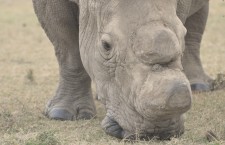
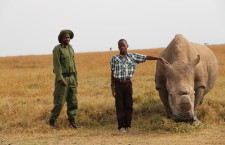

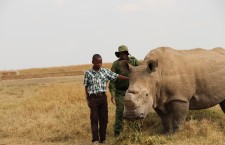
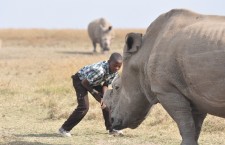
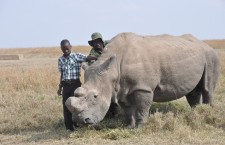
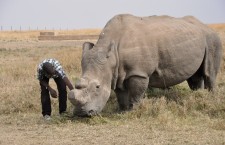
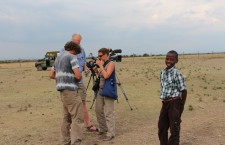
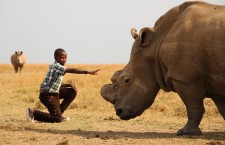
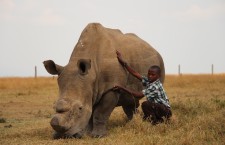
its such a pity that some individuals only think about their selfish needs and result to poaching of such unique creatures. thanks to such conservancies as olpajeta that the remaining few can call a home. we all need to create awareness among the communities and show the the importance of these wonderful creatures. it begins with me. and i will mobilise others
I really like the picture with Newton cuddling beside Sudan the best…It looks friendlier.
The connection between helping people and conserving wildlife is one of the greatest strengths of PA-MOJA.
Alison Stuart,
Director